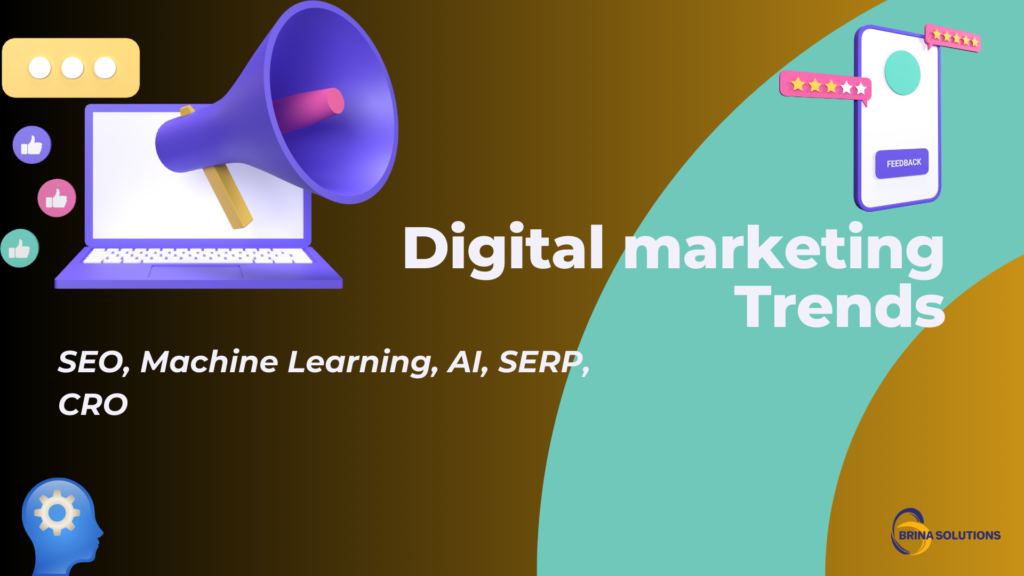Digital Marketing Trends
Digital marketing has become the lifeblood of successful businesses in today’s hyperconnected world. As traditional marketing tactics lose ground to more dynamic, technology-driven strategies, businesses must adapt to stay competitive. Understanding the future of digital marketing is essential for any company that seeks growth and sustainability in an ever-evolving marketplace. This blog will explore the most significant digital marketing trends shaping the future of the industry, explaining how they impact businesses and why you can’t afford to ignore them.

1. Artificial Intelligence (AI) and Machine Learning (ML) in Marketing
AI and ML have already started revolutionizing digital marketing by providing better personalization, automation, and predictive analytics. AI algorithms can analyze vast amounts of data, recognize patterns, and make data-driven decisions in real time. Businesses are increasingly using AI to improve customer experiences, target more effectively, and optimize marketing campaigns.
Some applications of AI in digital marketing include:
– Chatbots: AI-driven chatbots can engage with users in real-time, answering questions and guiding them through the sales process. This leads to better customer engagement and higher conversion rates.
– Personalization: AI can analyze customer behavior and preferences to deliver personalized experiences. Whether it’s customizing website content, email marketing campaigns, or product recommendations, personalization is key to building customer loyalty.
– Content Creation: AI tools can generate content ideas, write basic blog posts, or even create personalized email templates, freeing up time for marketers to focus on strategy.
The takeaway: *AI is here to stay. Businesses that invest in AI-driven marketing tools will have a competitive advantage by delivering more targeted, efficient, and data-backed campaigns*.
2. The Rise of Video Marketing
Video content has become a dominant force in digital marketing, with platforms like YouTube, TikTok, and Instagram Reels driving user engagement through short, impactful videos. Video marketing is no longer limited to social media; it has expanded to websites, emails, and even live streaming events.
– Live Video Streaming: Livestreaming allows businesses to engage with their audience in real time, whether through webinars, product launches, or Q&A sessions. This direct interaction can help build a strong brand community.
– Short-Form Video: Platforms like TikTok and Instagram have popularized short-form videos, which are easy to consume and share. Businesses can use this trend to create bite-sized, engaging content that resonates with users.
– Shoppable Videos: E-commerce platforms are integrating “shoppable videos” where viewers can make purchases directly from video content. This creates a seamless shopping experience and boosts conversion rates.
The takeaway: Businesses should integrate video into their digital marketing strategy to boost engagement, drive traffic, and increase conversions. Video content is highly shareable and memorable, making it a powerful tool for storytelling and brand awareness.
3. Voice Search Optimization
Voice search is on the rise, thanks to the growing use of digital assistants like Siri, Alexa, and Google Assistant. As more consumers rely on voice search to find products and services, businesses must optimize their content for voice search to remain competitive.
Key considerations for voice search optimization:
– Conversational Keywords: Voice search queries are often longer and more conversational than text searches. Businesses should focus on optimizing for natural language and long-tail keywords.
– Local SEO: Many voice search queries are local, such as “best coffee shop near me.” Optimizing for local SEO by ensuring your business is listed on Google My Business and other relevant directories is crucial.
– Answering Questions: Most voice searches are question-based, so creating content that answers common customer questions can help improve your ranking in voice search results.
The takeaway: Voice search optimization is essential for businesses that want to capture a growing segment of the market. By tailoring your SEO strategy to include voice-friendly keywords and content, you can stay ahead of the curve.
4. Influencer Marketing Evolution
Influencer marketing has grown rapidly, and its future looks bright. Brands are increasingly partnering with influencers to promote their products, particularly on social media platforms like Instagram, TikTok, and YouTube. Influencers, with their loyal and engaged followings, can provide brands with credibility and reach.
– Micro-Influencers: While big-name influencers can drive massive exposure, many brands are turning to micro-influencers who have smaller but highly engaged audiences. Micro-influencers often foster deeper connections with their followers, leading to better trust and more meaningful engagement.
– Authenticity Matters: As influencer marketing evolves, authenticity has become crucial. Consumers are becoming more discerning and prefer influencers who genuinely believe in the products they promote. Brands should focus on building long-term relationships with influencers who align with their values and can authentically represent their products.
The takeaway: Businesses should explore influencer partnerships that are authentic and aligned with their brand. Engaging with the right influencers can help drive awareness, build trust, and expand your customer base.
5. The Impact of Privacy and Data Regulations
As digital privacy concerns grow, data protection laws such as the GDPR (General Data Protection Regulation) in Europe and the CCPA (California Consumer Privacy Act) in the U.S. are becoming more stringent. These regulations impact how businesses collect, store, and use consumer data.
– First-Party Data: With the decline of third-party cookies, businesses must focus on collecting first-party data (information collected directly from customers) through methods like email signups, surveys, and loyalty programs. First-party data is more reliable and aligns with privacy regulations.
– Transparency and Consent: Businesses must ensure that they are transparent about data collection practices and obtain explicit consent from users. This builds trust and helps companies avoid legal complications.
The takeaway: The future of digital marketing will be data-driven, but with a focus on ethical practices and user privacy. Businesses that prioritize transparency and invest in collecting first-party data will stay compliant while building customer trust.
6. Augmented Reality (AR) and Virtual Reality (VR) Experiences
Augmented reality (AR) and virtual reality (VR) are no longer futuristic concepts; they are becoming essential tools for marketers, especially in industries like retail, real estate, and entertainment. These technologies offer interactive, immersive experiences that can significantly enhance customer engagement.
– Virtual Try-Ons: AR technology allows customers to “try on” products virtually before making a purchase. Whether it’s trying on clothes, makeup, or furniture, AR can reduce the uncertainty in online shopping and increase sales.
– Virtual Showrooms: VR technology enables businesses to create virtual showrooms, allowing customers to explore products or services in a virtual space. This can be particularly effective for industries like real estate or automotive sales.
– Interactive Ads: AR and VR can be integrated into marketing campaigns to create interactive ads that engage users in a more immersive way.
The takeaway: Businesses that incorporate AR and VR into their digital marketing strategies can provide customers with innovative, engaging experiences. These technologies can enhance product interaction, boost sales, and set your brand apart from competitors.
7. Social Commerce is Here to Stay
Social commerce refers to the use of social media platforms like Instagram, Facebook, and Pinterest to facilitate e-commerce transactions. These platforms have integrated shopping features that allow users to discover products, engage with brands, and make purchases without leaving the app.
– Seamless Shopping Experience: Social commerce removes friction from the buying process, allowing users to shop directly from their favorite social media platforms.
– User-Generated Content (UGC): UGC, such as customer reviews, photos, and videos, plays a vital role in social commerce. Brands can leverage UGC to build trust and create authentic connections with their audience.
– Social Ads: Paid social media ads are becoming more sophisticated, with features like shoppable ads and retargeting that drive conversions. Brands can create highly targeted campaigns based on user behavior and preferences.
The takeaway: Social commerce is a rapidly growing trend, and businesses should capitalize on it by integrating shopping experiences into their social media strategies. Creating a seamless path from discovery to purchase will improve customer engagement and boost sales.
8. The Power of Data-Driven Marketing
Data-driven marketing is the practice of using data insights to guide marketing strategies and decision-making. With the abundance of data available, businesses can no longer afford to rely on guesswork.
– Predictive Analytics: Predictive analytics uses historical data to predict future trends and customer behaviors. This helps businesses optimize their marketing campaigns, identify opportunities, and improve targeting.
– Customer Segmentation: Data allows businesses to segment their audience more effectively, ensuring that marketing messages are relevant and personalized.
– Marketing Automation: Automation tools powered by data can streamline marketing efforts, – from sending personalized emails to managing social media posts. This leads to increased efficiency and better customer engagement.
The takeaway: Businesses that embrace data-driven marketing will have a clear competitive edge. By leveraging data insights, companies can create more targeted, effective campaigns that drive results.
How Brina Solutions Can Help
The digital marketing landscape is rapidly evolving, and businesses that don’t adapt risk falling behind. From AI and video marketing to AR and data-driven strategies, the future of digital marketing is packed with opportunities for growth. At Brina Solutions, we understand the complexities of these trends and how to implement them effectively to help your business thrive.
Brina Solutions offers a comprehensive suite of digital marketing services, including AI-driven campaigns, influencer partnerships, social media management, and video marketing strategies. Let us help you navigate the future of digital marketing, optimize your campaigns, and unlock new growth opportunities.
Contact us today to learn how we can tailor a digital marketing strategy that meets your unique business needs and keeps you ahead of the competition!







Leave a Reply